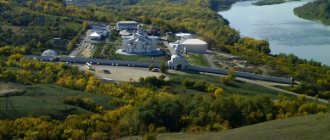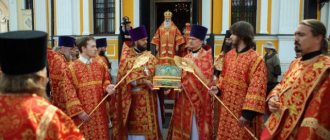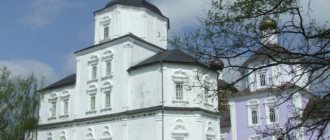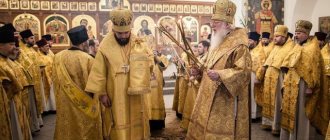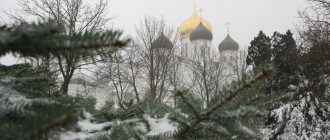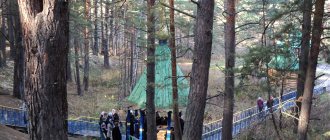Mir
Ukraine Kyiv Holy Intercession Monastery (Goloseevskaya Pustyn) Map is loading…
{"format":"leaflet","minzoom":false,"maxzoom":false,"limit":50,"offset":0,"link":"all","sort":[""], "order":[],"headers":"show","mainlabel":"","intro":"","outro":"","searchlabel":"\u2026 \u0441\u043b\u0435\ u0434\u0443\u044e\u0449\u0438\u0435 \u0440\u0435\u0437\u0443\u043b\u044c\u0442\u0430\u0442\u044b","default":"","import-annotation":false,"width ":"auto","height":"350px","centre":{"text":"","title":"""link":"""lat":50.37827800000000166846803040243685245513916015625,"lon": 30.510075000000000500222085975110530853271484375,"icon":""},"title":"","label":"","icon":"","lines":[],"polygons":[],"circles":[ ],"rectangles":[],"copycoords":false,"static":false,"zoom":8,"defzoom":14,"layers":["OpenStreetMap"],"image layers":[] ,"overlays":[],"resizable":false,"fullscreen":true,"scrollwheelzoom":true,"cluster":false,"clustermaxzoom":9,"clusterzoomonclick":true,"clustermaxradius":80, "clusterspiderfy":true,"geojson":"","clicktarget":"","showtitle":true,"hidenamespace":false,"template":"","userparam":"","activeicon": "","pagelabel":false,"ajaxcoordproperty":"","ajaxquery":"","locations":[{"text":"\u003Cb\u003E\u003Ca href=\"/palomnik/%D0% A1%D0%B2%D1%8F%D1%82%D0%BE-%D0%9F%D0%BE%D0%BA%D1%80%D0%BE%D0%B2%D1%81%D0%BA %D0%B8%D0%B9_%D0%BC%D1%83%D0%B6%D1%81%D0%BA%D0%BE%D0%B9_%D0%BC%D0%BE%D0%BD%D0 %B0%D1%81%D1%82%D1%8B%D1%80%D1%8C_(%D0%93%D0%BE%D0%BB%D0%BE%D1%81%D0%B5%D0% B5%D0%B2%D1%81%D0%BA%D0%B0%D1%8F_%D0%BF%D1%83%D1%81%D1%82%D1%8B%D0%BD%D1%8C) \" title=\"\u0421\u0432\u044f\u0442\u043e-\u041f\u043e\u043a\u0440\u043e\u0432\u0441\u043a\u0438\u0439 \u043c\u0443\u0436\u0441\ u043a\u043e\ u0439 \u043c\u043e\u043d\u0430\u0441\u0442\u044b\u0440\u044c (\u0413\u043e\u043b\u043e\u0441\u0435\u0435\u0432\u0441\u043a\u0 430\u044f\u043f\u0443\u0441 \u0442\u044b\u043d\u044c)\»\u003E\u0421\u0432\u044f\u0442\u043e-\u041f\u043e\u043a\u0440\u043e\u0432\u0441\u043a\u0438\u043 9\u043c\u0443\u0436 \u0441\u043a\u043e\u0439 \u043c\u043e\u043d\u0430\u0441\u0442\u044b\u0440\u044c (\u0413\u043e\u043b\u043e\u0441\u0435\u0435\ u0432\u0441\u043a\u0430\ u044f\u043f\u0443\u0441\u0442\u044b\u043d\u044c)\u003C/a\u003E\u003C/b\u003E\u003Chr /\u003E\u003Ca href=\"/palomnik/%D0%A1%D0%B2 %D0%BE%D0%B9%D1%81%D1%82%D0%B2%D0%BE:%D0%90%D0%BD%D0%BD%D0%BE%D1%82%D0%B0% D1%. \u044f\"\u003E\u0410\u043d\u043d\u043e\u0442\u0430\u0446\u0438\u044f\u003C/a\u003E: \u0413\u043e\u043b\u043e\u0441\u0435\u0 435\u0432\u0441\ u043a\u0430\u044f \u043f\u0443\u0441\u0442\u044b\u043d\u044c \u2014 \u043c\u0435\u0441\u0442\u043e \u043c\u043e\u043d\u0430\ u0448\u0435\u0441\u043a\u0438\ u0445 \u043f\u043e\u0434\u0432\u0438\u0433\u043e\u0432 \u043a\u0438\u0435\u0432\u0441\u043a\u0438\u0445 \u043f\u043e\u0434\u 0432\u0438\u0436\u043d\u0438\ u043a\u043e\u0432 \u0431\u043b\u0430\u0433\u043e\u0447\u0435\u0441\u0442\u0438\u044f XVIII\u2014XIX \u0432\u0435\u043a\u043e\u043 2,\u0430\u0441\u043e\u0432\ u0442\u043e\u0440\u043e\u0439 \u043f\u043e\u043b\u043e\u0432\u0438\u043d\u044b XIX \u0441\u0442\u043e\u043b\u0435\u0442\u0438\u 044f\u2014\u0440\u0435\u0437 \u0438\u0434\u0435\u043d\u0446\u0438\u044f \u041a\u0438\u0435\u0432\u0441\u043a\u0438\u0445 \u043c\u0438\u0442\u0440\u043e\ u043f\u043e\u043b\u0438\u0442 \u043e\u0432. \u041f\u0440\u0438 \u043e\u0431\u0438\u0442\u0435\u043b\u0438 \u0438\u043c\u0435\u0435\u0442\u0441\u044f \u0433\u043e\u0441 \u0442\u0438\u043d\u0438\u0446 \u0430.","title":"\u0421\u0432\u044f\u0442\u043e-\u041f\u043e\u043a\u0440\u043e\u0432\u0441\u043a\u0438\u0439 \u043c\u0443\u0436 \u0441\ u043a\u043e\u0439 \u043c\u043e\u043d\u0430\u0441\u0442\u044b\u0440\u044c (\u0413\u043e\u043b\u043e\u0441\u0435\u0435\u0432\u0 441\u043a\u0430\u044f\u043f \u0443\u0441\u0442\u044b\u043d\u044c)","link":"","lat":50.37827800000000166846803040243685245513916015625,"lon":30.51007500000000050 0222085975110530853271484375,"icon":""}],,"imageLayers":[]}
50.378278; 30.510075
Ukraine, Kyiv, Colonel Zatevakhina street, 14
Kyiv
Ukraine
Telephone:
(044) 527-82-19.
Holy Intercession Monastery, Goloseevskaya Hermitage
- a men's monastery located in the forest on the southern outskirts of Kyiv. Goloseevskaya Hermitage is the place of monastic exploits of Kyiv ascetics of piety in the 18th-19th centuries, and from the second half of the 19th century - the residence of the Kyiv metropolitans. There is a hotel at the monastery.
History[edit]
Saint Peter (Grave, +1647, commemorated December 31/January 13) drew attention to the special beauty and solitude of the picturesque neighborhood of Kyiv - Goloseev. He acquired part of the forest along with a small clearing as his own property and built here a temple in the name of the Great Martyr John of Sochava and several cell houses for the brethren. Thus, the foundation was laid for the monastery of the Kiev-Pechersk Lavra, later called the Goloseevskaya Hermitage.
Over time, the temple was renamed in honor of the icon of the Mother of God, called the “Life-Giving Source.” In 1910-1912, a new stone church was built on the site of the old wooden one.
In addition to temples and cells in the Goloseevskaya hermitage there was a summer residence of the Kyiv metropolitans with a house church in honor of St. John the Long-Suffering, Pechersk, a hotel, a Lavra farmstead and other buildings.
In 1852, with the blessing of the ruling bishop, St. Philaret, Metropolitan of Kyiv and Galicia (Amphiteatrov), the monastery was named Holy Protection.
In Goloseevsky solitude, Saints Peter (Grave) and Philaret (Amphitheaters, +1857, commemorated December 21/January 3), the Venerable Parthenius of Kiev (Krasnopevtsev, +1855, commemorated March 17/30) and Alexy Goloseevsky (Shepelev, +1917, commemorated) asceticised. March 11/24), for Christ's sake the holy fools Theophilus (Gorenkovsky, +1853, commemorated October 28/November 10) and Paisiy (Yarotsky, +1893). All of them are glorified by the Ukrainian Orthodox Church as locally revered saints.
In 1926, nine years after the October Revolution, the Goloseevskaya Hermitage was abolished. During the Soviet period of history, all its churches and buildings were destroyed, with the exception of the house of the Kyiv metropolitans. Three monastic priests, who labored in the monastery at different times, accepted martyrdom for Christ and intercede for us before the Throne of the Most High. These are the venerable martyrs – Cassian (Kuzyk), Ippolit (Semyonov) and Philip (Bezugly).
During the Great Patriotic War, the second line of defense for the city of Kyiv passed through the Goloseevskaya Hermitage. Fierce fighting took place here. However, not a single shell hit the monastic cemetery where the Monk Alexy Goloseevsky was buried. And in the years of persecution, and in the years of persecution, and in terrible times of war, a lamp always burned on his grave and people sought the Heavenly Light to follow its unfading flame.
In 1993, the monastery was opened as a monastery of the Kiev Pechersk Lavra. Archimandrite Isaac (Andronik) was appointed head of the monastery. In the same year, on October 4, according to the new style, the relics of St. Alexy Goloseevsky were found and a house church was opened in honor of St. John the Long-Suffering. In 1996, according to the decision of the Holy Synod, Goloseevskaya Hermitage became an independent monastery. A temple in honor of the icon of the Mother of God, called the “Life-Giving Source,” and a monastic cemetery have been restored in it; a new church was built on the site of the former metropolitan house; Monastic and administrative buildings, the governor's house with a house church in honor of the Holy Royal Passion-Bearers, a hotel and other monastic buildings grew.
History of the place
First St. Peter Mogila (1647) bought this place that he liked and laid out the first man-made park, which over time grew and merged with the forest. Later the temple of the Great Martyr was founded. John of New Sochaevsky and the Lavra’s country monastery was built. In the middle of the 19th century, this picturesque monastery turned into the residence of the Kyiv Metropolitans.
A new revival of the monastery began in 1845 under Metropolitan of Kiev Filaret (Amphiteatrov), who somehow fell in love with these green lands in a special way. First, he built a metropolitan house and a stone church with boundaries in honor of St. John of Sochaevsky and the Three Saints, since they were preceded by wooden buildings. Then the Holy Intercession Church was rebuilt with chapels in honor of the icon of the Mother of God “Life-Giving Source”. This entire complex with churches, cells, hotels, utility yard and other buildings, numbering 10 buildings, was called the Holy Protection Hermitage.
Patronal holidays[edit]
Protection of the Blessed Virgin Mary
- October 14
Icon of the Most Holy Theotokos “Life-Giving Spring”
— April 21 (transitionable)
Days of remembrance of the Great Martyr. John the New, Sochavsky (June 2/15),
Prpp. John the Long-Suffering (July 18/31) and Alexy Goloseevsky (March 11/24 and September 21/October 4),
Cathedral of the Three Saints
- 12th of February
Barlaam and Joasaph of India (December 2 - November 19).
Particularly honored holidays:
- Days of remembrance for each of the saints. Kiev-Pechersk,
- sschmch. Vladimir, Metropolitan Kievsky (January 25/February 7 and June 14/27),
- St. Philaret, Metropolitan of Kyiv (December 21/January 3),
- St. Peter's Mogila (December 31/January 13), St. Parthenia (March 17/30),
- blzh. Theophila (October 28/November 10)
- blzh. Paisia (April 17/30).
Goloseevskaya Pustyn. Mother Alipia: address
In 1979, the holy fool Alipia (in the world Avdeeva Agafya Tikhonovna) settled on the ruins of the monastery monastery and began to constantly pray for the revival of the monastery. She also predicted his blossoming.
This is how Mother Alypia contributed to the revival of such a monastery as Goloseevskaya Pustyn. How to get to this place will be described a little further. It must be said that mother rested on October 30, 1988 and was buried at a completely different end of the city of Kyiv, namely at the Lesnoy cemetery. On May 18, 2006, with the blessing of His Beatitude Metropolitan Vladimir of Kyiv, her honorable remains were transferred to the Goloseevsky Monastery and are now located in the tomb of the church in honor of the icon of the Mother of God “Life-Giving Source”.
In 1993, another revival of the monastery began. On October 4 of the same year, the discovery of the relics of Saint St. Alexy Goloseevsky, who died on March 11, 1917. In 1996, Pustyn Goloseevskaya received the status of an independent monastery. Today it has been completely restored and has become even more gracious and beautiful.
Where to stay[edit]
Pilgrims coming to the Holy Intercession Goloseevskaya Hermitage are given the opportunity to settle.
Not far from the temple there is a four-story hotel building with a range of hotel services necessary for living.
When checking in, you must have your passport (original).
At the monastery there is a monastery refectory where you can eat from 8:00 to 20:00, you can also order: lunch for a group of pilgrims, a funeral lunch, to celebrate: the days of the guardian angel, wedding and baptism.
Contacts:
Hotel: +38
Monastery tea room: (096) 052-83-87
Church shop: (098) 900-22-47
Biography of Mother Alipia
The Wonderworker was born on March 3, 1905 into the family of pious Christians Avdeev Tikhon and Vassa from the village of Vysheteley (Gorodishchensky district of the Penza province). She was named in honor of the martyr Agathia, whose icon she then carried on her back all her life.
Mother Alypia quickly learned to read and write as a child and read many sacred books. The Psalter became her favorite, and she prayed from it. Together with her parents, she often visited the village church in honor of the apostles Peter and Paul. The old woman endured sorrows and hardships from childhood. Her parents were shot in Civil right before her eyes. From that moment on, her wandering life of begging began, accompanied by persecution by the authorities. She even had to be captured by S. Budyonny, who was touched by her childhood tears, and he ordered the girl to be released.
However, she always relied on God, even though she had to spend the night in the open air and do temporary part-time jobs in order to get her daily bread. For a long time she pilgrimaged to holy places, where she found refuge, joy and peace. During all the years of war and disbelief, Mother Alypia spent about 10 years in prison. There was a case when one day the Apostle Paul himself brought her out of death row. During the Great Patriotic War she also had to endure imprisonment in a concentration camp. Her faith in God always saved her.
Photo[edit]
- Holy Intercession Monastery (Goloseevskaya Hermitage)
- Holy Intercession Monastery (Goloseevskaya Hermitage)
- Holy Intercession Monastery (Goloseevskaya Hermitage)
- Holy Intercession Monastery (Goloseevskaya Hermitage)
- Holy Intercession Monastery (Goloseevskaya Hermitage)
- Holy Intercession Monastery (Goloseevskaya Hermitage)
origin of name
According to the first version, this area received the name Pustyn Goloseevskaya, allegedly because of the bare land on which a forest park area was formed. And according to the second, it comes from the word “voice,” since during the Mongol-Tatar invasion, women distraught with grief came here and all wailed together, thus mourning their dead relatives.
Before tackling the main questions asked by many believers, such as: “Where is the Goloseevskaya Pustyn?”; “How to get from metro station “Goloseevskaya”?” and “What is the service schedule?” - Let's dive into history a little. After all, the Goloseevskaya Hermitage became the place of monastic exploits of Kyiv saints of the 18th-19th centuries.
tonsure
She took monastic vows at the Kiev Pechersk Lavra. Foolishness from Christ is the most difficult monastic feat for which she struggled. Her life was spent in strict fasting and incessant prayer, short sleep and constant physical labor. People will forever remember her as silent and prayerfully self-absorbed, but boundlessly loving God and her neighbors. What was surprising was the fact, which was revealed shortly after her death, that for every person for whom she had to pray, she hung an iron key around her neck. By the end of his life, this “necklace” of iron keys turned into real chains.
Reverence
This great ascetic spent nine years in the Goloseevsky monastery. She always prayed incessantly and continued the exploits of the venerable fathers of Goloseevsky. The Lord honored her with great spiritual gifts: insight, foresight, consolation, healing and, finally, the most important thing - the gift of love. She herself predicted her death. This happened on October 30, 1988. During her lifetime, she helped countless people, but even after her death, through prayer addressed to Mother Alipia, real miracles and healings still occur.
Today, every day, and especially on the days of her veneration, the Goloseevskaya Hermitage receives thousands of people from all over the world. The Golossevo Monastery has collected countless testimonies of healings. When the coffin with the remains of mother was brought into the church, a cross appeared in the sky. On the same day, two seriously ill people suffering from cancer received healing.
LiveInternetLiveInternet
“If there is consolation and joy on earth, it is in desert silence. People separate us from God, but the desert brings us closer to Him.”
Venerable Parthenius of Kyiv
There are many beautiful and picturesque corners in Kiev, where you want to return again and again. One of these, one might say, quiet, devoid of any noisy bustle of the metropolis, is Goloseevo... “If you want, I’ll show you the Russian Athos, with its deep forests and small hermitages ? I will lead you to such mountains and forests as you have probably never seen. There is a place to be silent..." St. Philaret (Amphitheaters)
In 1993, the monastery was revived.
In a picturesque tract between the hills, in the depths of a huge forest park, “sown” in the 18th century. On the bare ground and therefore called Goloseevsky there is the Holy Intercession Goloseevsky hermitage. On the site of the desert there once stood the farm of the Kiev Pechersk Lavra. In the first half of the 17th century. Moldavian boyar Petru Movila, the future saint Peter Mogila, Metropolitan of Kiev and at the same time the Lavra rector, founder of the Kiev Collegium at the Brotherly Monastery, which over time became the famous Kiev-Mogila Academy, captivated by the beauty of the surroundings of the farm, planted a garden here, built a house for himself and a church in the name of a compatriot, Moldavian John of Sochava, canonized. This is how the monastery arose, which over time became the summer residence of the Kyiv metropolitans who presided over the Lavra.
Under the Protection of the Mother of God, Metropolitan Philaret and his spiritual father, Hieroschemamonk Parfeniy, lived in Goloseevo (every spring and summer for the last 17 years of his life). Both were already revered as elders during their lifetime.
The Monk Parthenius served the Liturgy daily in the Goloseevskaya Hermitage, after which he went into the forest and read the Psalter while walking in it. He was not only a great man of prayer, but also a man of a crystal clear soul who did not know a single unclean thought. During his lifetime, his contemporaries called him “an earthly angel and a heavenly man.”
Parthenius especially reverently honored Good Friday and the Feast of the Annunciation of the Blessed Virgin Mary, and the Lord called him to Himself in 1855, when Good Friday and the Annunciation coincided on the same day. The wondrous old man was buried in the Goloseevskaya Church in the name of the icon of the Mother of God, called the “Life-Giving Spring.”
Blessed Theophilus (Gorenkovsky; †I853), a fool for Christ, labored for several years in the Goloseevskaya Hermitage. He lived in Goloseevo twice: at the beginning of his feat of foolishness and in the very flowering of his ascetic life. Saint Philaret wanted to keep him here forever: he greatly valued asceticism and ascetics. But the high feat of the blessed one required complete loneliness, so he was eventually transferred to the Kitaevskaya Hermitage, where he rested in the Lord in 1853.
Before embarking on the feat of foolishness in the Goloseevskaya Hermitage, another famous Kiev blessed lived, testing himself and strengthening himself spiritually - for Christ's sake the holy fool Paisius (Yarotsky, †1893). He carried two obediences to the skete - a note taker and a reader of the prayer rule for Bishop Philaret. All these ascetics of piety, glorified in the twentieth century in the ranks of the locally revered saints of the Ukrainian Orthodox Church, took part in the fate of another remarkable Kyiv elder - St. Alexy Goloseevsky.
Reverend Alexy Goloseevsky (in the world - Vladimir Ivanovich Shepelev) was born on Easter 1840 in the family of a major of the Kiev Arsenal. He was the ninth child in the family. His mother, Maria Kazimirovna, who converted to Orthodoxy from Catholicism, was distinguished by her special piety and piety. Eight years before the birth of the boy, Saint Anthony of Voronezh predicted to her that she would have a crippled son who would be God’s servant. Vladimir was born mute. For 12 years the pious mother begged God for the boy’s healing. She visited the Kyiv elders with him and asked for their prayers, giving out a lot of alms to the sick and prisoners with the boy’s hands. On Easter 1853, Bishop Philaret healed Volodya of muteness. The first words of the healed youth were the words “Truly he is risen” - the answer to the Easter greeting of the saint. According to the conditions of that time, the children of nobles were obliged to receive an education in military schools and after that serve in the rank of officer. But the Lord miraculously rejected His chosen one from the secular life of an officer and sent him to a monastery.
On April 15, 1857, Vladimir Shepelev was enrolled by the Spiritual Council among the actual novices of the Lavra, leaving him in his previous obedience - at the printing house. At the printing house, Vladimir’s obedience went well. Always obedient, he carefully fulfilled all duties, all assignments assigned to him, attended church services and read useful books. But the devil tries to put obstacles on the path of salvation for every ascetic. The novice Vladimir also had to experience temptation from the enemy of human salvation.
During the novitiate of Vladimir Shepelev, the holy fool Ivan Grigorievich, nicknamed “Barefoot”, and last name Kovalevsky, often appeared among the Lavra pilgrims for Christ’s sake. He was a visionary man. And then one day this wanderer meets the novice Vladimir in the monastery courtyard and says to him: “Beware, beautiful Joseph, of the female sex, beware of fire... otherwise they will soon destroy you.” “Yes, I never look at them anyway,” the young novice answered bashfully. “And now, even more so, turn away from them: soon they will come to the Lavra according to your liking.” As the holy fool said for Christ’s sake, so it happened. A month after the said conversation, a landowner familiar to the Shepelev family comes to the Lavra and begins to use all possible efforts to pull the young man out of the monastery in order to marry him. And although novice Vladimir did not express any desire to leave the Lavra, his secular relatives, who did not understand the height of monastic service, insisted on this. And only the authoritative intervention in this matter of the governor of the Lavra, who was then Archimandrite. Varlaam, brought sense to the relatives of the novice Vladimir and cooled the ardor of the selfish landowner. Vladimir still stayed in the Lavra, remaining a novice until 1872, when he was given monastic vows. Before his tonsure as a monk, novice Vladimir went to Voronezh to venerate St. Mitrofan, during the opening of whose relics Archbishop. Anthony predicted his birth. Then he served a memorial service in Voronezh and over the grave of the archbishop. Antonia.
Archim. Varlaam, the governor of the Lavra, knew the love of the novice Vladimir Shepelev for his benefactor, Metropolitan. Philaret and therefore, intending to tonsure Vladimir as a monk, on paper assigned him a monastic name - Philaret. But then the day of tonsure arrived - Maundy Thursday of Holy Week 1872, April 13th. The tonsure was performed by the archbishop himself. Varlaam in the Anthony Church of the Near Caves. When it was time to call Vladimir a new name at the rite of tonsure, Archimandrite. Varlaam forgot the name that he decided to call Vladimir as a monk, and some secret voice told him another name: Alexy. So, after a moment of struggle with himself, he named Vladimir Alexy in honor of Alexy, the man of God, celebrated on March 17th.
After the tonsure of Fr. Alexy soon became a monk, on September 12 of the same year, from the printing house he was transferred to serve as a note taker at the hospital “Nicholas Monastery,” which is the name of one of the churches of K.-P. Lavra, which has its own special abbot, reporting directly to the Spiritual Council of the Lavra. Here about. In the year of his tonsure as a monk, on the day of remembrance of St. Mitrophan of Voronezh - November 23rd - Alexy received ordination to the rank of hierodeacon. St. Mitrophan of Voronezh was like an angel. Alexia: on the day of the opening of the relics of St. Mitrofan's mother Fr. Alexia received a prediction about his birth, healing from Fr. Alexy due to muteness occurred in the Mitrophanievskaya Church and now, the ordination to the rank of hierodeacon of Fr. Alexy took place again on the day of remembrance of St. Mitrofan.
Recorder at the Nicholas Monastery, Fr. Alexy was until December 23, 1874, when he was appointed sacristan of the same monastery. From the time of service of Fr. Alexy, a hierodeacon at the Nicholas Monastery, has one piece of material evidence of his spiritual mood at that period of his life. The reverend donated there is still preserved in the altar of the St. Nicholas Church. Alexy a silver glass for drinking after St. Communions with the inscription: “For the repose of Hierod. Alexia (Shepeleva).” This glass indicates that Rev. Alexy was already thinking about death and tried through prayer and good deeds to prepare himself for a worthy meeting with it.
December 6, 1875 Fr. Alexy was elevated to Metropolitan. Arseny to the rank of hieromonk. This ordination took place unexpectedly, both for Fr. Alexy, and for those around him. December 6th, the day of St. Nicholas, was the patronal day in the St. Nicholas Monastery. In 1875, on this day, Metropolitan Arseny himself expressed a desire to serve here. For this solemn day, at the direction of the Lavra authorities, they were preparing for ordination: one monk to the rank of hierodeacon, and one hierodeacon to the rank of hieromonk. But in a few days, the governor of the Lavra, Archimandrite. Varlaam has a dream. Saint Nicholas appears to him and orders him to present Hierodeacon Alexy for ordination to hieromonk. Archim. Varlaam tells his dream to Metropolitan Arseny. The Metropolitan, having listened to the story, ordered that the hierodeacon scheduled for ordination on December 6 be left until another holiday, and hierodeacon Alexy be brought in instead. So unexpectedly and miraculously the ordination to the rank of hieromonk took place. He was entrusted with a new obedience, which he then carried out at various churches of the Lavra until the end of his days - this was clergy.
On August 20, 1879, Fr. Alexy was transferred by the Spiritual Council from the post of sacristan of the Nicholas Monastery to the same obedience to the Near Caves. The position of sacristan in the caves for Fr. Alexia was one of the pleasant obediences. Opening the crayfish of the saints in the morning, watching for the cleanliness of the bedspreads and coffins in which the saints rested. relics - this was not difficult for Father Alexy, but provided only spiritual consolation. There, in the caves, at the relics of St. saints and prayer flowed more freely from his heart; there he forgot everything worldly and, always seeing the incorruptible saints resting before him, involuntarily strove to imitate them.
How much about. Alexy was a good sacristan, this can be seen from the words of the head of the Far Caves at that time. When the head of the Far Caves needed a new sacristan, he came to the governor of the Lavra and said: “Give me a sacristan like the sacristan of the Near Caves - Fr. Alexy." For the pilgrims who visited the caves in many places, Fr. Alexy was always affectionate and friendly. No one could guide you through the caves so affectionately and talk intelligently about the Pechora ascetics as Fr. Alexy. His Eminence Plato, who was then Metropolitan of Kyiv, knew about this and therefore often instructed Fr. Alexia to accompany the guests of honor through the caves.
In the Goloseevskaya hermitage, St. Alexy lived 21 years, 3 months and 24 days. His main responsibilities here were: regular divine services, supervision of the sacristy and clergy. Clergy and supervision of the sacristy by Fr. Alexy did not leave his days until the end, and he was released from the next divine service, due to his painful condition, just a year before his death. The first years of his stay in the Goloseevskaya Hermitage. Alexy spent his time as usual, like all other hieromonks: he performed divine services, looked after order in the church and confessed to the people who came. One thing that made him different from the others was his enthusiastic reading of the teachings after the sacramental verse. But over time, with wise advice and timely warnings, he began to attract the attention of Orthodox people: first in the villages adjacent to the desert, then in the city of Kyiv and, finally, throughout vast Russia. About Rev. Alexia was known in Petrograd, Moscow, the Caucasus, Siberia, and the Don. He was known in cities, villages, and monasteries. Such wide popularity of Fr. Alexy is not difficult to explain: the many pilgrims who visited the Kiev-Pechersk Lavra met here with Fr. Alexy and, kindly and reassured by him, spread the news about him to all corners of our vast fatherland. In the last years of his life, Rev. Alexy at the door of his cell could be seen every day several visitors who came to him for advice, for relief from their grief, with requests for the living and the dead. Nothing kept visitors from Fr. Alexia: neither cold, nor heat, nor rain, nor snow; to Rev. They visited Alexy in the summer, and in the winter, and in early spring, and in late autumn, but most of all the elder was burdened with visitors in the summer, when nothing prevented the journey to the Goloseevsk Hermitage.
At the cell of St. Alexy could be met with priests, monks, and laity. K o. Both the rich and the poor, the noble and the ignorant, the learned and the uneducated, those who cared about their salvation and those who had forgotten how to please God came to Alexey... But most of all, the poor people crowded around the saint’s cell, which he fed not only with the word of God, but also our daily bread. O. Alexy received everyone equally, tried to treat everyone kindly, and help everyone in some way. And indeed, he helped suffering people. His people entered his cell upset, with gloomy faces, excited, and came out calm, peaceful, with tears of joy in their eyes.
Not only pilgrims and monks, but also archpastors and even the Kyiv metropolitans sought pacification of their conscience from Elder Alexy. So, Chernigov Archbishop. Anthony called Fr. Alexy to himself in Chernigov in April 1911 for a dying spiritual conversation and in his arms he gave up his spirit to God. The Goloseevskaya hermitage is nothing more than the summer cottage of the Kyiv metropolitans, where they rest in the summer from their archpastoral labors. During his stay Fr. Alexy in the Goloseevsk Hermitage, the Kiev Metropolitan See was replaced by four archpastors: His Eminence Ioannikiy Rudnev (1891 - 1900), Theognost Lebedev (1900 - 1903), Flavian Gorodetsky (1903 - 1915) and Vladimir Epiphany (1915 - 1918). Two of them, who stayed especially long at the Kyiv See - Metropolitan. Ioannikiy and Metr. Flavian - had Fr. Alexy as his confessor, and Met. Vladimir asked Fr. for prayers several times. Alexia. And today many believers prayerfully go to the priest for gracious help...
Reverend Father Alexie, pray to God for us!
Cross on the grave of St. Alexy Goloseevsky.
In a private house near the desert, the Kiev ascetic of Christ for the sake of the holy fool Alipia (Avdeeva; died 1988) lived for a long time and died.
There are ascetics in the Orthodox Church who are close and understandable to everyone; they are especially loved by the people. The Kiev ascetic of our time, nun Alipia (Avdeeva), .
They come and go to her, distressed by everyday hardships, the destitute and desperate, the sick, the poor and orphans - everyone receives attention, care, love, mercy, consolation from her.
The relics of Mother Alipia rest in the lower church “Life-Giving Source”, entrance on the right.
Temple in honor of the Icon of the Mother of God "Life-Giving Spring"
The people's heart feels this and responds to the love of the blessed old woman. Books have been written about her life, a huge amount of information has been collected about her miracles, but these books cannot contain all the cases of the old woman’s help. Thousands of them are stored on the pages of the hearts of people who have received the blessed mercy. All these cases cannot be described due to their multitude. Some of them, by the will of God, become known to God-loving readers.
The life of Mother Alipia was deprived of the glory that the blessed one has after her death. The old woman avoided fame all her life, shunning praise. Often foolishness, the most difficult feat, was her saving refuge. For most of her life she had no shelter, avoided peace, toughening her life with many exploits.
But the peculiarity of the old woman was her enormous sense of gratitude: to God, whom she always thanked in everything, and to the person who did her even the slightest good deed.
You won’t even notice him, but Mother always noticed everything: “Thank you! Yes, save me! I will bow at your feet . One day, during a period of wandering, Mother got wet and chilled from the rain. The husband of the owner of one house, who had previously not wanted to let her in, unexpectedly offered to come into their house and warm up, he heated the stove, and his wife made him bed for the night. And a few days later the woman met Mother in the temple, and the old woman turned to her: “Do you know that your husband is registered with God! Do you know what he did to me?!” If one of those who came helped the old woman with the housework or in the garden, she always gave him some money. Of course, no one wanted to take them, but it was impossible to refuse the old lady’s persistent requests. The truth of the Orthodox faith for Mother Alipia was undeniable. It leads to Orthodoxy both during life and after death and testifies that salvation is only in the true canonical Orthodox Church. So one young man, who secretly began to go to Pentecostals from Mother, repeatedly heard from her hidden prohibitions to go to them. When the question of a final decision arose, a direct prohibition followed: “Save yourself here! This is the truth!” In response to his complaint that he did not understand anything about Orthodoxy, Mother predicted to him that he would soon meet a priest who would instruct him in everything, which is what happened. Later the young man became a priest. Also, when a man came to the old lady, who had professed Judaism before baptism, which he did not tell Mother about, the old lady praised him for doing the right thing and going to Christ.
The cross is on the spot where the house where Mother Alipia lived stood.
Chapel on the site where Mother Alypia lived and carried out spiritual deeds
The cap of Mother Alipia , which she wore, is located and displayed for application every day on the territory of the Chapel (on the site where Mother Alipia's house was). Therefore, you have the opportunity to bow to this shrine and ask for grace from our intercessor.
Blessed Mother Alipia, pray to God for us...
The grave of Monk Varlaam, in the world of V.V. Khrustitsky - Lieutenant General of the IMF.
As they say, the ways of the Lord are mysterious and My thoughts are not your thoughts... The Lord calls each person to Himself in different ways...
Military figure. Lieutenant General of the Navy. Honorary member of the Military Intelligence Veterans Foundation. Academician of the International Academy of Bioenergy Technologies. The son of Hero of the Soviet Union Vladislav Vladislavovich Khrustitsky, Vladimir Vladislavovich Khrustitsky, took monastic orders in early 2007 with the name Varlaam . Died on June 20, 2007. He was buried in the cemetery of the Holy Intercession Monastery of the Goloseevskaya Hermitage. Born February 23, 1930. Since 1941, he was brought up in the Leningrad orphanage named after Kirov. In 1944-1945 - son of the regiment of the 30th Guards Tank Brigade of the Leningrad and Baltic fronts. In 1949 he graduated from the Kiev School of Self-Propelled Artillery named after M.V. Frunze. In 1962 - the Military Academy of Armored Forces, in 1973 - the Military Academy of the General Staff, in 1981 - higher academic courses at the Military Academy of the General Staff. He served as commander of a tank platoon, company, battalion, deputy commander of a tank regiment, regiment commander, deputy commander of a motorized rifle division in the Leningrad, Kiev, Ural, Belorussian, North Caucasus, Transbaikal military districts, and a group of Soviet troops in Germany. After graduating from the Military Academy of the General Staff, he became commander of the 20th Tank Division (Northern Group of Forces). First Deputy Commander of the 35th Combined Arms Army (Red Banner Far Eastern Military District). In 1979-1989 - Deputy Commander of the Pacific Fleet. During his service, he was Chairman of the State Commission for testing automatic small arms of 5.45 mm caliber designed by Kalashnikov and Konstantinov (1974); on testing the BTR-70 and T-80, T-72 tanks (1979). Participated in long sea voyages. Was the commander of the garrison of the city of Vladivostok. In 1989, he retired from the Armed Forces due to health reasons, a 2nd group disabled person. After his dismissal, he worked as part of the State Delegation of Ukraine on the division of the Black Sea Fleet, was an adviser to the Commander of the Ukrainian Navy, Chairman of the Committee for Promoting the Creation of the Ukrainian Navy, one of the founders of the Main Research Center of the General Staff of the Armed Forces of Ukraine. Participated in the work of the 1st and 2nd World Congress of Ukrainians, the Congress of National Democratic Forces, and took part in the work of congresses of Ukrainian officers. Awarded two Orders of the Red Star, the Order of Bogdan Khmelnitsky III degree, For Service to the Motherland in the USSR Armed Forces III degree, the Badge of Honour, the medal “For Military Merit”, more than 30 medals of the USSR, Ukraine, foreign states, public organizations and the Ukrainian Orthodox Church .
At the monastery cemetery
Grave of schema-abbot Gerontius (Zakharov).
The spiritual children of the schema-abbot and many who need spiritual reinforcement come to Father Gerontius at the grave...
Holy saints of God, ascetics of the Goloseevskaya Hermitage, pray to God for us...
